Search
Remove Ads
Advertisement
Summary 
Loading AI-generated summary based on World History Encyclopedia articles ...
Search Results
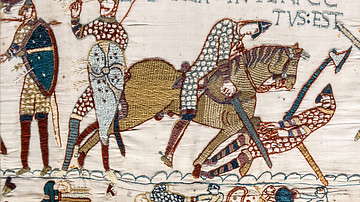
Definition
Bayeux Tapestry
The Bayeux Tapestry shows in pictures the events leading up to the Norman conquest of England by William the Conqueror, Duke of Normandy, and his 1066 defeat of King Harold Godwinson at the Battle of Hastings. It was produced between 1067...

Image
Bayeux Tapestry: Detail from Battle of Hastings
This detail from Bayeux Tapestry depicts Bishop Odo of Bayeux, half-brother of William the Conqueror, rallying the troops at the Battle of Hastings. The tapestry is believed to date to the eleventh century CE. As can be seen, the artifact...

Definition
Arachne
Arachne, from the Greek arákhnē (meaning spider), is a figure in Greek mythology whose talent for weaving was renowned and who famously challenged the goddess Minerva to a weaving competition. As told in Ovid’s (43 BCE-17 CE) Metamorphoses...

Definition
Odo of Bayeux
Odo of Bayeux (d. 1097 CE) was the bishop of Bayeux in Normandy and half-brother of William the Conqueror (r. 1066-1087 CE). After the Norman conquest of England in 1066 CE, Odo was given vast Anglo-Saxon estates and made, as the Earl of...

Image
Death of Harold, Bayeux Tapestry
A scene from the 11th century CE Bayeux Tapestry showing the death of King Harold of England at the Battle of Hastings in 1066 CE. (Centre Guillaume le Conquérant, Bayeux, France)
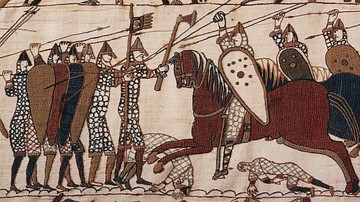
Image
Battle of Hastings, Bayeux Tapestry
A scene from the 11th century CE Bayeux Tapestry showing Norman cavalry charging Anglo-Saxon infantry at the Battle of Hastings in 1066 CE. (Centre Guillaume le Conquérant, Bayeux, France)
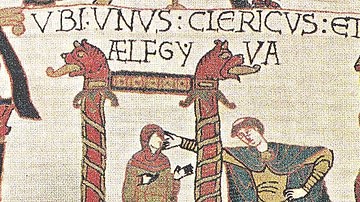
Image
Aelfgifu Scene, Bayeux Tapestry
A woman named Aelfgifu with a clergyman, depicted on the Bayeux Tapestry, made c. 1067-1079. The identity of Aelfgifu is unclear, and the name was common among Old English royal women. Two leading candidates for being the Aelfgifu in this...
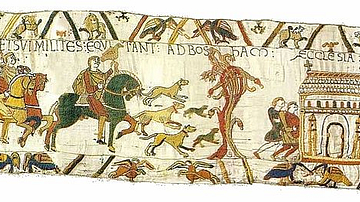
Image
Harold Godwinson on a Hunt, Bayeux Tapestry
A detail from the 11th Century CE Bayeux Tapestry, showing Harold Godwinson (c. 1023 - 1066 CE) with a hunting falcon and collared hunting dogs.
The Bayeux Tapestry is currently on display in the Bayeux Museum in France.
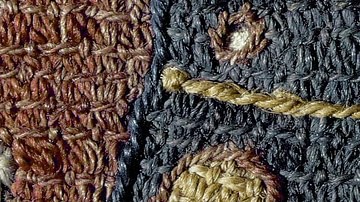
Image
Stitching in the Bayeux Tapestry
Shown here is a detail from the Bayeux Tapestry. Though referred to as a tapestry, it is a linen cloth that features embroidery in eight different-colored wools. 11th century CE.

Image
William the Conqueror, Bayeux Tapestry
A scene from the 11th century CE Bayeux Tapestry showing William the Conqueror (second figure from the left) at the Battle of Hastings in 1066 CE. (Centre Guillaume le Conquérant, Bayeux, France)